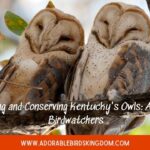Idaho’s diverse habitats are a haven for a variety of wildlife, including several species of owls. From the majestic Great Horned Owl to the diminutive Northern Pygmy-Owl, Idaho’s nocturnal birds of prey offer a fascinating glimpse into the state’s rich biodiversity.
I’ve spent years observing and studying these intriguing creatures. Their unique behaviors, adaptations, and vital roles in the ecosystem never cease to amaze me. This article will shed light on the owls of Idaho, their habitats, and the challenges they face.
Whether you’re a bird enthusiast or just curious about Idaho’s wildlife, there’s something captivating about these nocturnal hunters. Stick around as we dive into the world of Idaho’s owls and explore the secrets of their nocturnal lives.
Great Horned Owl: Idaho’s Majestic Predator
Here in the Gem State, we are fortunate enough to host the Great Horned Owl, a majestic predator that plays a pivotal role within our ecosystems. They are like the sentinels of the night, their large, round, yellow eyes, reminiscent of glowing lanterns cutting through the inky darkness. I’ve had countless nights observing these magnificent creatures, and the experience is nothing short of awe-inspiring.
These birds are readily identified by their striking appearance. A tuft of feathers, resembling ears or horns, protrudes from their heads, giving them their popular name. Plumed in motley shades of brown and grey, their dense feathering provides not only excellent camouflage but also resistance to Idaho’s often frigid temperatures.
Let’s explore what makes the Great Horned Owl stand out among Idaho’s nocturnal hunters. Sounds like an exciting adventure, right? Well, it is! I’ve been studying these fascinating creatures for years and they still continue to astound and amaze me.
Their unparalleled strength, for starters, sets them apart from the rest. Outfitted with some of the most powerful talons in the bird kingdom, they’re capable of exerting nearly 300 pounds of pressure per square inch. That’s more than enough to nab and grip their prey with shocking efficiency.
Their menu of choice is also notably diverse compared to other owls in Idaho. I’ve found evidence of prey ranging from small rodents to even larger creatures like skunks and hares. Here’s a breakdown of their dietary habits:
| Prey Type | Percent Composition in Diet |
|---|---|
| Rodents | 70% |
| Birds | 20% |
| Rabbits | 10% |
The versatility of the Great Horned Owl’s diet reflects the adaptability and tenacity of these impressive predators. But this isn’t the only factor that highlights their adaptability. Great Horned Owls, unlike some of the more selective owl species, can be found in a variety of habitats across Idaho. From our dense woodlands to the shrubby lowlands, they’ve made Idaho their home and they are as integral to our landscapes as our landscapes are to them.
Northern Pygmy-Owl: The Tiny Owl of the Gem State
Stepping away from the champion predator, the Great Horned Owl, let’s cast our gaze on another fascinating owl species from Idaho—the Northern Pygmy-Owl. Don’t be fooled by the Pygmy-Owl’s petite size; there’s much to admire in this tiny predator.
First off, the Northern Pygmy-Owl stands out with its distinctive physical characteristics. I’ve often spotted these owls, no more than seven inches tall, carrying prey that’s larger than them! It’s a testament to their might and resolve, size notwithstanding. Their gray-brown plumage allows for perfect camouflage within Idaho’s dense forests, whereas their yellow eyes can pierce through the murkiest of dusks.
One striking feature of these owls that I’ve noticed is their two conspicuous black spots on the back of their heads, akin to a pair of false eyes. It’s an ingenious natural defense tactic to ward off predatory attacks.
Let’s dig into the Northern Pygmy-Owl’s diet habits. They’ve earned the moniker ‘diurnal raptors’ because they can hunt both at night and during the day. It’s quite amazing to observe their potent ability to snatch up insects, small rodents, even other smaller birds. It’s proof that size doesn’t deter their predatory prowess.
Speaking from years of observation, I find their adaptability remarkable. Northern Pygmy-Owls can inhabit a variety of habitats, from the lowland riparian areas to the high-altitude coniferous forests scattered across Idaho. So, the next time you’re out exploring the Gem State, keep an eye out for these miniature marvels of nature. Their presence, although often elusive, adds a unique flavor to Idaho’s rich wildlife tapestry.
This narrative on the tiny yet intriguing Northern Pygmy-Owl underscores its place in the local ecosystems, embodying its importance as a key predator and an essential element of Idaho’s diverse habitats.
Habitat Diversity: Homes of Idaho’s Owl Species
Idaho’s richness in terms of habitat diversity has made it a host to different owl species like the Northern Pygmy-Owl and the Great Horned Owl. Each having unique needs and adaptations. Let’s delve deeper into the diverse habitats of these incredible creatures.
The Northern Pygmy-Owl may be small but it’s rugged. It’s found in a wide range of habitats, preferring the dense and mixed forests with an ample supply of undergrowth. It’s not unusual to spot these owls in the middle and higher elevations, nestled cozily within the heavily wooded areas of Idaho.
Riding the waves of the wind, the Great Horned Owl stakes out a territory across diverse habitats. It doesn’t shy away from deserts, wetlands, forests, grasslands, backyards, or even city parks. If you’re in Idaho, you’re probably not far from a Great Horned Owl. What makes them so adaptable is their less fussy diet and inches of feathers for insulation.
But it’s not only the Northern Pygmy-Owl and the Great Horned Owl we find in Idaho. The state is home to a total of 16 owl species. The diverse terrains – from the Idaho Panhandle’s lush northern forests to the rugged south’s arid sagebrush steppe – fail not in providing suitable homes for these different species.
Each owl species brings its unique touch, adding layers to the complex ecological tapestry of Idaho. You’ll find these owls carving out homes, shaping the environment, and playing their vital role in the ecosystem.
Next, let’s look at the specific roosting and nesting habits of our feathered friends, focusing on the Northern Pygmy-Owl and Great Horned Owl. This will provide a more intimate view of their daily life and reproductive habits.
Conservation Efforts: Protecting Idaho’s Owls
As an owl enthusiast, I’m encouraged by Idaho’s multi-faceted conservation approach. The state’s programs and initiatives strive to ensure the survival of all 16 owl species.
The Idaho Department of Fish and Game has been spearheading most of these efforts, with a keen interest in protecting all birds of prey, including our beloved owls. A central part of their initiative centers on habitat conservation. It’s no secret that habitats like forests, marshes, and grasslands are essential for owls’ survival. Idaho’s approach ensures they’re adequately preserved. The state also recognizes the significance of maintaining urban environments that serve as homes for adaptable owls like the Great Horned Owl.
Additionally, local wildlife rescue and rehabilitation centers play a crucial part in Idaho’s owl conservation efforts. These centers care for injured or sick owls and prepare them for release back into their natural habitats. In 2019 alone, these centers successfully rehabilitated and released hundreds of owls back into the wild.
| Year | Number of Owls Rehabilitated |
|---|---|
| 2019 | Hundreds |
Research is another pivotal factor in the protection of owls, and Idaho is not lacking in that department. State biologists, in partnership with university research teams, conduct detailed studies on owl behavior, breeding patterns, and food habits. This research provides valuable insights into the factors that contribute to the owl populations’ health and longevity.
Public education and community involvement are also prioritized, increasing awareness about the vital role owls play in Idaho’s ecosystem. From public talks to information boards and digital platforms, numerous avenues ensure residents and visitors alike learn about the owls’ importance and the need to protect them.
Every aspect of Idaho’s conservation efforts focuses on creating a sustainable environment for owls, making sure every species can continue to play its part in the state’s ecological tapestry.
Fascinating Behaviors: Insights into the Lives of Idaho’s Nocturnal Birds
In their unique role as predators under moonlight, Idaho owls possess extraordinary behaviors. Being primarily nocturnal creatures, they’ve fine-tuned their survival strategies to a night-time lifestyle, flaunting an array of unique hunting and communication tactics.
Let’s begin with their hunting skills. Having to navigate through the dark, these owls utilize a powerful sense of hearing to locate prey. Some owl species, like the Barn Owl, have asymmetrical ears. This unique adaptation is vital—it allows them to accurately judge the height, distance, and direction of their prey, perfecting a stealthy swoop-in to make their catch. Their silent flight, facilitated by special feather adaptations, is another remarkable feature. It ensures that their approach is nearly inaudible to the ears of unsuspecting creatures that find themselves on the owl’s menu.
When it comes to communication, Idaho’s owl species depend heavily on vocalizations. From the eerie screech of the Barn Owl to the haunting hoots of the Great Horned Owl, each sound serves a purpose. Owls use these calls to claim territory, convey a sense of urgency, or even bond with a mate. It’s their owl-specific language—a concoction of hoots, screeches, and mews that make up the nightly orchestra in Idaho’s wilderness.
Some other interesting behaviors include roosting and nesting. Unlike other birds, many owl species prefer roosting in dark, secluded spaces during the day, like tree hollows or old buildings. Nesting is another unique attribute—several species, notably the Burrowing Owl, nest underground in burrows dug by mammals such as ground squirrels and badgers.
Through research collaborations with universities and observation in rescue centers, we’re starting to understand more about the complexity and diversity of these avian species’ lifestyles. Clearly, Idaho’s owls are more than mere nocturnal hunters—they are testimony to the marvel of adaptation and survival. It’s their ecological significance that drives the continued commitment to their preservation. Getting to know the lives of Idaho’s nocturnal birds allows us to understand why every effort counts in safeguarding their existence.
Conclusion
I’ve taken you on a journey through the nocturnal world of Idaho’s owls, showcasing their stealthy hunting skills, vocal communication, and unique nesting habits. These magnificent creatures, with their silent flight and acute hearing, play a vital role in Idaho’s ecosystem. Their behaviors, from hoots to roosting, are intriguing and complex, making them a captivating subject for research and observation. It’s clear that these remarkable birds, with their significant ecological roles, need our help to thrive. Conservation efforts are crucial to ensure their survival. So let’s value and protect our feathered friends, understanding that their presence enriches our natural world. The world of Idaho’s owls is a world worth preserving.



